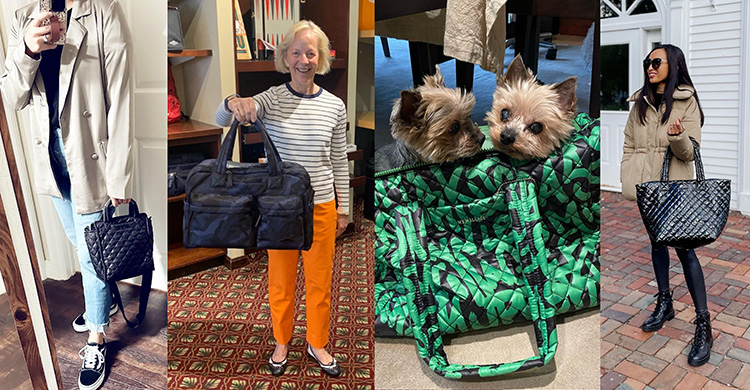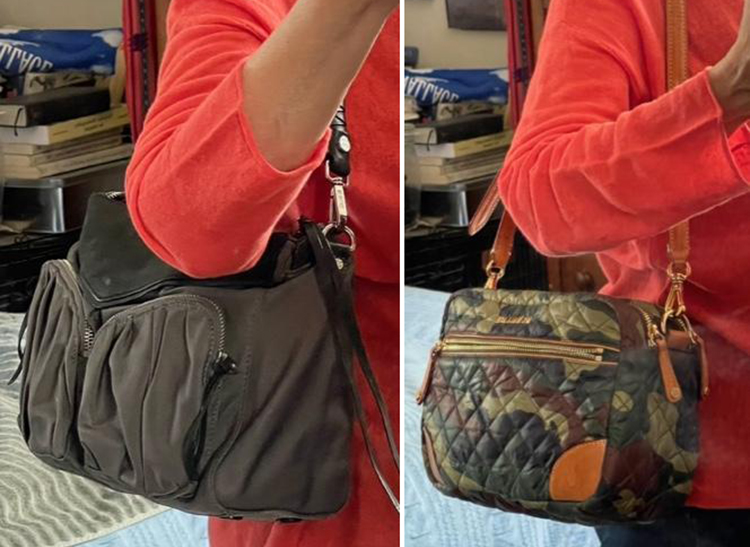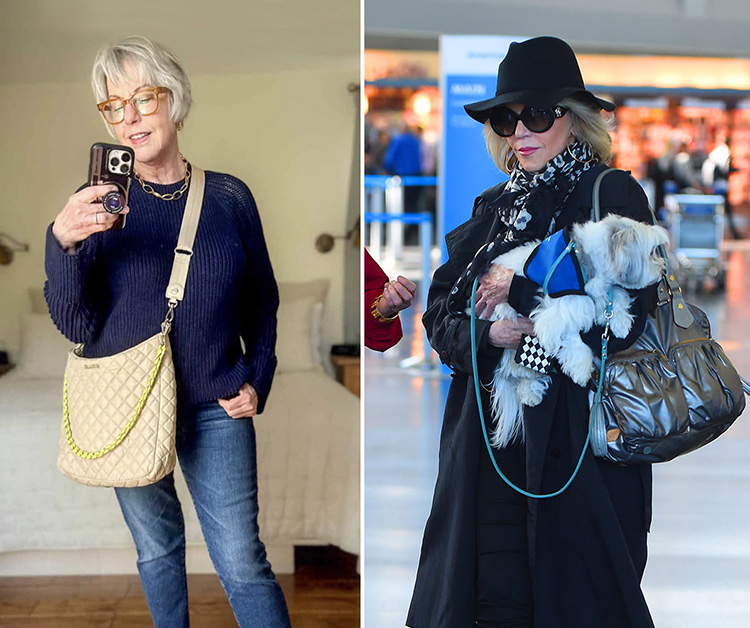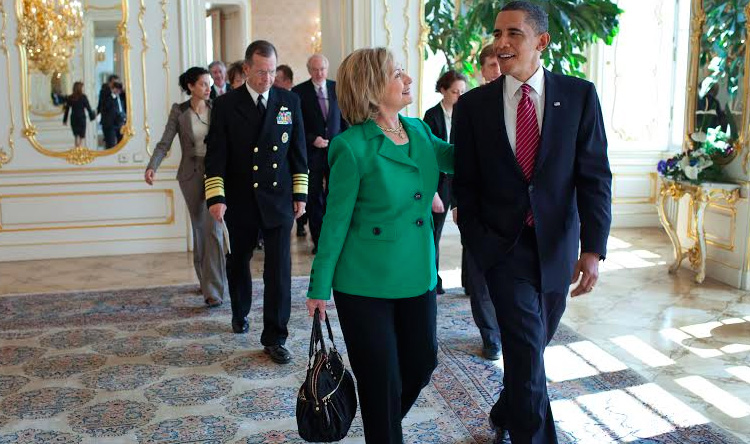ENTER YOUR EMAIL TO RECEIVE OUR WEEKLY NEWSLETTER
A Love Affair Gone Sour—With MZ Wallace
Inside a cult-favorite handbag brand that’s all about function-first frumpinesss
By Millie Iselin

Showoffs. Instagrammers displaying—and in one case luxuriating inside—their (or their owner’s) MZ Wallace handbags.
. . . . . . . . . . . . .
Updated March 3, 2024
I’ll start with a question: What do we want from our handbags? Different women have different needs and desires for their purses. (What a word—PURSES! Its secondary meaning invokes puckered lips and pouts.) Do we change them daily to complement our outfits, or do we wear the same bag for months or years on end? (My preference is for the latter.) Small, large, hard, soft, leather, pleather, fabric, straw, or something else? Light, heavy, compartmentalized, organized, pouched, bottomless pit, open, closed, clutch, shoulder bag, backpack, tote? Neutral, colorful, textured, basic? Minimalist, adorned? What governs their selection? Perhaps it’s haphazard?
And here are some more questions: Are we what we own? Do our possessions define us, or are they the window dressing to who we are? Handbags, in particular, contain our identity and daily wherewithal, as per our driver’s license, credit cards, cash—stuff. They’re fraught with meaning. What happens when they become us? Is buying them a need, a hobby, or a hunger? Do they appease or stave off boredom? Is owning numerous bags akin to gluttony? Is collecting a cult? Is being part of a cult OK?
And is MZ Wallace—the handbag brand I’m focused on at the moment—a cult? In owning and wearing Wallace hags, had I become an unintended member of a cult? I suspect that what initially made them desirable or perhaps collectible, for me and maybe others, was that they were almost anti-chic. The brand is known for its signature use of lightweight but sturdy nylon—more recently diamond-quilted—to produce a billowy effect and a feeling of softness It began with a reputation for pleating, contrasting-lining, red leather-edging, and overt metal fittings. In fact, Wallace bags are perhaps their own version of chic, not unlike the Little Black Dress. With their handy exterior pockets and zippers, they seem to me to embody a statement of practicality. Of putting it all out there. What’s more, these bags come in a wide color range, with mostly contrasting interiors (for visibility), and with lots of pockets and compartments. They’re efficient, no-nonsense, and well-organized. No wonder the brand avoids using periods between the M and the Z—as if it were above the mundane constraints of punctuation.
So, like the glove leather Coach brand, wildly popular in the late ’80s and ’90s, Wallace handbags come across as handsome in a utilitarian way. There is almost what some would call a deliberate function-first frumpiness to them, with their multiple exterior and interior pockets and their slouchy, non-architectural silhouettes. The nylon they’re made of hints of parachutes, and they could almost be military issue, ready for adventure…for escape. From the outset, they looked promising to me. Therein was the lure.

Elbow action. The author’s, as she displays her Thompson Crossbody, left, and her Crosby, right. She calls the latter “good for travel, because of its organization and compact size.”
. . . . . . . . . . . . .
I tend to buy based largely on function, but style is a definite plus. I’ve had the same wallet for years, because it works–it suits my needs. I sometimes wish that it was a bit smaller. But whenever I look at smaller wallets, they just don’t have the qualities that I appreciate. My mother had a green leather wallet with an engraved gold-tone plate for as long as I can recall. It must have suited her needs. Friends tease me that I carry too much in my bag, and orthopedists and chiropractors have told me, in no uncertain terms, on behalf of my bad shoulders, to lighten up.
The Wallace flagship is located in New York’s prime high-toned Downtown shopping turf, Soho. There’s also a company store in Chicago. The brand is sold, as well, in such elevated department stores as Bloomingdale’s, Nordstrom, Bergdorf Goodman, Saks Fifth Avenue, and Neiman Marcus, and, interestingly, in neighborhood shops—in suburban towns like Larchmont, N.Y. and Ridgewood, N.J. (Many Wallace aficionados are homemakers and commuters.) What’s more, the bags are available at branches of the Equinox Fitness Club (its members being busy urban types who need sizable bags for transporting their gym clothes and sneakers—and who evidently like the convenience of shopping at their gym.) And then there are the hotshot ecommerce sites, like Vestiare Collective and Modesens, not to mention ebay, that do a brisk Wallace trade. Most Wallace sales are made at these outlets and via the brand’s own website, mzwallace.com.
Once the 2020 shutdown set in and the shops closed, purchasing flourished online. Maybe Wallace customers had a desire to connect with like-minded others, and maybe their purchases were a form of wish fulfilment that we’d surely be out and about soon enough—so why not celebrate that pending reemergence with a brand new Wallace bag? The increase in online activity may well explain how Wallace chat groups–there are two of them on Facebook–not only gained momentum, but became integral to the brand’s cult success. These Facebook groups actively discuss new releases, customer service issues, fabrication flaws. They also consult with each other about how long to hold onto Wallace bags and when it’s time for an online fire sale.
I first came across Wallace handbags in 2017-2018, when they were mentioned in Une Femme d’un Certain Âge, the blog run by Susan Blakey, a Los Angeles writer and fashion stylist. But it wasn’t until a year or so later that I made my first Wallace purchase: a grey Thompson Crossbody, part of the Bedford collection. (Some Wallace bags and collections are named after New York streets. Urbanity, or at least hints of it, are part of the brand’s appeal.) The Thompson is pleated and shirred, but not quilted (quilting is something that came after the shirred bags), with six interior pockets. multiple exterior compartments, interchangeable straps, and Italian leather detailing. It was not too big for me, not too small. It traveled well. It was durable. My large, beloved wallet, phone, and eyeglasses fit inside comfortably and then some. Yet this handbag weighed under a pound!
As I came to appreciate it, I grew curious about the culture surrounding the brand, which led me to the Wallace-oriented Facebook groups. But what proved most interesting were those who purchased these bags—the range of women to whom the bags appealed. (No men ever seemed to speak up.) These were middle class young mothers trying to balance home and work. These were older professional women who commuted with their bags. These were big city as well as more rural women. These were teachers and students trying to squeeze everything into their daily bag.

MZ Wallace-ites. Une femme d’un certain âge blogger, Susan Blakey, left, taking a selfie to show off her Crosby Hobo; Jane Fonda (yes, that’s her), right, carrying Tulea, her Coton de Tulear (that’s the dog), with her Jane tote (as it’s known) slung over her shoulder. We wonder if Fonda inspired the name of this bag.
. . . . . . . . . . . . .
The bags, manufactured in China and Vietnam, are mostly mid-range in price, though they start at $25 for a (very) tiny pouch, and climb to $385 for the Crosby Daily Tote, while the larger Weekender (a cross between a handbag and a soft-sided valise) goes for $425, and the International Carry-On is listed at $445. Bestsellers, like the Large Magnet Metro Tote, go for $295—not inexpensive, but accessible. In the past, an educational discount for teachers and students was available via a separate web page, which reduced the bite for some. I suspect that it featured loss leaders, remainders, and misses, along with old merchandise. Probably also, these discounts enabled unsold or returned stock to be made available to a market that admired nylon Prada handbags but couldn’t afford their higher prices. That’s moot now; those educational options were discontinued during Covid, which also seems to reflect a change in the company’s philosophical orientation—one of less concern for doing good.
MZ Wallace is a New York enterprise, founded in 1999 by two fashion industry friends. Monica Zwirner was a stylist who’d worked with Gucci, BMW, and Lancôme, among others, before moving on to interior design at Selldorf Architects. Lucy Wallace Eustice was the accessories editor at Harper’s Bazaar and Elle. As young working mothers, they knew the need for multi-functional handbags. Evidently, the two of them do the designing.
Their target market was women like them, who “needed bags that could go from day to night, from the office to evening plans or errands,” as per the Wallace website.
During Covid, new releases scarcely hiccoughed, even though the bags and their owners barely ventured beyond the pod. But people were dying out there! While other merchants switched production to masks or made donations to relevant causes, Wallace resisted, and sales remained focused. Also, in apparent denial of the world around them, customers complained about poor service, about fabrication flaws—peeling lacquer on the fabric, uneven stitching. They questioned whether the placement of a pattern on a particular bag made it unacceptable or undesirable. They protested over delivery people traipsing across their lawns.

Remember those days? Secretary of State Hillary Clinton in a White House procession with her boss on her left and her Bea bag in hand on her right.
. . . . . . . . . . . . .
Every so often, some customers recognized that they’d overindulged. Their closets were too full, a bag no longer quite worked, they’d wearied of a style, or perhaps already had it in multiple colors, despite it being carefully preserved in its cloud-patterned dust bag—which made the handbag that much more special. Time to pass it along to another aficionado, to hold an online fire sale, or to resell it via one of the services feeding the collectible secondhand fashion resale movement. This would permit customers to indulge again.
I watched their obsession from the safety of my desktop. The voraciousness of purchasing, the parading of their collections in front of peers, the need for the New, the Newest variation on the theme. Some releases passed muster; others faded away, while still others rapidly joined the canon. Styles and collections from the past were coveted, cloaked in nostalgia, and repeatedly re-sold to peers. IRL celebrity and colleague sightings were cherished. Jennifer Garner, Anne Hathaway, and Lupita Nyong’o wore these bags, validating the Wallace purchases of customers around the world. They were safe.
I was incredulous.
And then it almost became a habit.
True, occasional collaborations were made with artists and causes in the name of social consciousness. One, in 2021, with the Los Angeles-based Nigerian artist Njideka Akunyili Crosby, displayed the face and shoulders of an African girl gazing directly at the viewer from the surface of the Metro tote. Were these collaborations sincere and important to the market, or were they some sort of cultural appeasement that embodied the “appropriate” attitude—to the culture supposedly swirling around this brand? Over time, as I watched, there seemed to be fewer and fewer collaborations, less and less interest in reaching out. I sensed that the founders were very possibly becoming weary of their own success.
Disenchantment set in. Today, the bags seem less original. Knockoffs abound at much more reasonable prices. The pleating/shirring on my Thompson Bedford bag is almost completely a thing of the past. The leather corners are mostly gone. A comparison feature offered on the website no longer is very useful. The colors and shapes are less unique and now just seem to follow the latest market trends, so the innovation factor is diminished. At least there is still an occasional holiday release.
Unlike so many others, I was never a frenzied buyer. I was never a glutton. But I was always on the lookout for the next great bag—one that better suited my needs. I like the five MZW bags in my closet, some of which will probably see use well into the future. But the spark of discovery and comradery has gone. Maybe it’ll return one day? Out of style for many years, the abovementioned Coach Bags have lately returned to favor, as that company’s latest creative director, the British designer Stuart Vevers, shakes thing up with attention-grabbing new choices. Will Wallace take the same route? Maybe. And maybe that will happen under new ownership. Rumor has it that the ever-prescient Zwirner and Wallace Eustice have lately been looking to sell their company and just walk away.
Millie Iselin is a former—yet steadfast and unrepentant—New Yorker, who may from time to time be found residing in a state of canine-created bedlam (i.e., she breeds dogs on occasion). She maintains order (in her closets, at least) to help preserve her sanity and remain sorted out, she tells us.











